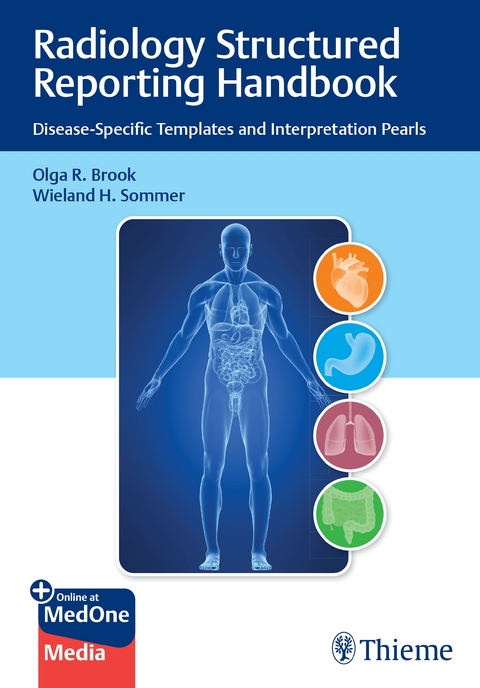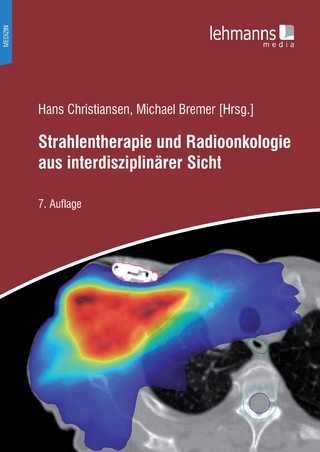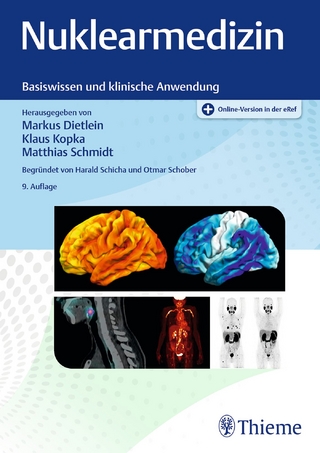
Radiology Structured Reporting Handbook
Thieme Medical Publishers Inc (Verlag)
978-1-68420-151-8 (ISBN)
Multiple studies show that referring physicians have a clear preference for structured radiology reports due to clarity and ease of interpretation, yet a one-size-fits all approach does not address disease complexities. Concurrently, the use of structured radiology templates has increased, driven in part by the need to comply with big data and artificial intelligence as well as reimbursement. Standardization of reporting is one of the first essential steps in the transformation of radiology from "the art of imaging" to a robust data science.
»Radiology Structured Reporting Handbook: Disease-Specific Templates and Interpretation Pearls« by Professors Olga R. Brook, Wieland H. Sommer, and esteemed colleagues is a highly practical guide on structured reporting for every major area of radiology. Featuring disease-specific templates, the book is organized in six sections and 53 chapters. Section one covers core foundation topics, from different definitions of structured reporting and pros and cons to change management and how to build templates. Five disease-specific sections encompass specific cancers and a variety of abdominal, thoracic, neurological, and cardiovascular diseases and conditions.
Key Highlights:
- Downloadable disease-specific templates for a variety of clinical entities including cardiovascular, thoracic, abdominal, oncological, and neuroradiology
- Essential interpretation pearls for specific diseases from top experts in a bullet format, accompanied by relevant figures and tables
Together, the templates and pearls provide an essential and unique practice resource for optimal and clinically relevant reporting. The book also serves as a succinct educational tool for radiology trainees and practicing radiologists who may not interpret specific highly specialized types of studies on a daily basis.
This book includes complimentary access to a digital copy on https://medone.thieme.com.
Section I. What Is Structured Reporting And Do We Need It?
Chapter 1 What Is Structured Reporting - Different Definitions Of Structured Reporting
Chapter 2 Pros And Cons Of Structured Reporting
Chapter 3 Change Management - How To Implement Structured Reporting
Chapter 4 How To Build A Template
Section II. Structured Reports in Cancer Imaging
Chapter 5 Lymphoma Staging PET-CT
Chapter 6 Pancreatic Cancer Initial Staging Exam Structured Report
Chapter 7 Rectal Cancer
Chapter 8 Prostate MRI
Chapter 9 Renal Mass MRI And CT
Chapter 10 Hepatocellular Carcinoma: LI-RADS And OPTN
Chapter 11 Hilar Cholangiocarcinoma
Chapter 12 Ovarian Cancer Staging
Chapter 13 Endometrial Cancer MRI Staging
Chapter 14 Cervical Cancer MRI Staging
Chapter 15 CT Staging Lung Cancer TNM 8
Chapter 16 Thyroid Ultrasound
Section III. Structured Reports in Abdominal Imaging
Chapter 17 CT Colonography
Chapter 18 CT/MR Enterography
Chapter 19 Perianal Fistulizing Disease On MRI
Chapter 20 Adrenal Incidentaloma On CT and MRI
Chapter 21 Adnexal Cyst On Ultrasound
Chapter 22 Fibroid MRI
Chapter 23 Pelvic Floor Dysfunction
Chapter 24 Endometriosis MRI
Chapter 25 Cystic Pancreatic Lesions: Template For CT And MRI
Chapter 26 Acute And Chronic Pancreatitis
Chapter 27 Placenta Accreta Spectrum MRI
Chapter 28 Ultrasound Of Liver Transplant
Chapter 29 Kidney Transplant
Chapter 30 Living Donor Liver Transplant
Section IV. Structured Reports in Thoracic Imaging
Chapter 31 Incidental Pulmonary Nodules
Chapter 32 CT Pulmonary Angiography
Chapter 33 Tracheobronchomalacia
Chapter 34 Fibrotic Lung Disease
Chapter 35 Pulmonary Hypertension CTPA
Chapter 36 Chronic Obstructive Pulmonary Disease
Chapter 37 Cystic Lung Disease
Chapter 38 Lung Cancer Screening
Chapter 39 Standard Reporting On Chest CT Findings Related To COVID-19
Chapter 40 COVID-19 On Chest X-Ray
Section V. Structured Reports in Neuroradiology
Chapter 41 Brain Tumors MRI
Chapter 42 Multiple Sclerosis
Chapter 43 CT/CTA For Acute Stroke Imaging
Chapter 44 Traumatic Brain Injury
Chapter 45 NI-RADS (Neck Imaging Reporting And Data System)
Chapter 46 Dementia
Section VI. Structured Reports in Cardiovascular Imaging
Chapter 47 Coronary CT-Angiography
Chapter 48 Transcatheter Aortic Valve Implantation (TAVI)
Chapter 49 Cardiac MR Examination: Cardiomyopathy In An Adult Patient
Chapter 50 Abdominal Aortic Aneurysm (AAA): Post-Procedural Surveillance
Chapter 51 Abdominal Aortic Aneurysm (AAA): Pre-Procedural Evaluation
Chapter 52 Coronary Arteries Calcium Quantitative CT Score
Chapter 53 FFR (Fractional Flow Reserve) CT For Coronary CTA
| Erscheinungsdatum | 08.06.2021 |
|---|---|
| Zusatzinfo | 125 Abbildungen |
| Verlagsort | New York |
| Sprache | englisch |
| Maße | 254 x 178 mm |
| Gewicht | 544 g |
| Einbandart | kartoniert |
| Themenwelt | Medizinische Fachgebiete ► Radiologie / Bildgebende Verfahren ► Nuklearmedizin |
| Medizinische Fachgebiete ► Radiologie / Bildgebende Verfahren ► Radiologie | |
| Schlagworte | downloadable radiology report templates • educational tool for trainees and practicing radiologists • practice resource for clinically relevant reporting • radiology reports • radiology report templates • radiology standards • radiology structured reports |
| ISBN-10 | 1-68420-151-9 / 1684201519 |
| ISBN-13 | 978-1-68420-151-8 / 9781684201518 |
| Zustand | Neuware |
| Haben Sie eine Frage zum Produkt? |
aus dem Bereich


